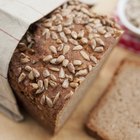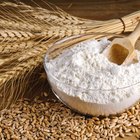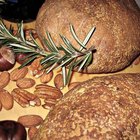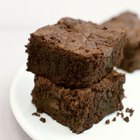kobeza/iStock/GettyImages
Rye bread plays an important role in the culinary traditions of central and eastern Europe. It's available in many forms, ranging from dense peasant breads to lighter, more elegant versions scented with caraway seeds or citrus zest. The richest and darkest variety is pumpernickel, native to the Westphalia region of Germany. Its color traditionally comes from a complex baking process, but is created artificially in supermarket versions.
About Rye
Rye is the only major grain other than wheat that contains enough gluten to make a decent loaf of bread. It's been domesticated for about 3,000 years, and it's valued by farmers in harsh climates for its ability to withstand cold, damp weather that kills wheat or causes it to rot in the fields. Rye produces a denser, sturdier loaf than wheat bread, and its ability to retain moisture -- up to four times as much as wheat flour -- gives rye breads exceptional shelf life.
Traditional Pumpernickel Bread
True pumpernickel bread starts with a uniquely coarse-ground flour, used primarily just for this specific bread. It's moistened and given an extensive fermentation period, while the natural yeasts and bacteria that populate rye flour turn it into a natural sourdough. The resulting acidity helps keep the bread dough elastic. Traditional recipes often include the leftover crumbs of previous loaves, adding deep flavors to the dough. Pumpernickel was traditionally the last bread baked for the day in the village baker's oven, spending up to 24 hours in the gentle heat of the cooling bricks. This combination of coarse flour, long fermentation and slow baking produces the traditional coffee-dark color.
Supermarket Pumpernickel
The breads sold as "pumpernickel" in most supermarkets and neighborhood bakeries are not nearly as complex. They're made from ordinary rye flour, often mixed with wheat flour to produce a lighter texture. Their dark color is usually provided by caramel coloring. This is made by heating sugar past the point of caramelization, until it reaches a molasses-dark color. The darker it gets, the less sweetness it retains. When added to baked goods or sauces, it gives them a rich, brown color. Unfortunately, it does nothing to create the signature flavor and texture of a true pumpernickel.
Comparison
The difference between artificially darkened rye bread and true pumpernickel is plainly evident when they're compared side by side. Supermarket pumpernickel has the light, fine crumb of any conventional bread. True pumpernickel has a dense, moist, almost cakelike consistency. Supermarket pumpernickel has the pleasant but unexceptional flavor of mainstream sandwich rye, while the real thing has a richly complex, sweet flavor filled with aromatic and nutty overtones. A few supermarket pumpernickel breads attempt to replicate the sweetness and elusive tang of pumpernickel by adding molasses, but the end result is still much less complex and satisfying.
Related Articles

Russian Rye Bread vs. Pumpernickel

How to Make Bread Tender

Differences Between Bleached Flour & ...

What Additives Are in Flour?
Is Unbleached Flour the Same as ...

What Is Artisan Bread?
Can You Refrigerate Homemade Yeast ...
Quick and Easy French Bread Recipe

Does Bread Expire?

Does It Matter if I Substitute Baking ...

How to Freeze Brioche

What Does Cornstarch Do in Baking ...

Whole Eggs Vs. Egg Yolks for Sweet Bread

Can You Substitute Whole Wheat Pastry ...

Why Does Bread Drop in the Middle When ...

How to Make Pasta Dura Bread

How to Make Bread Chewy

How Do Different Types of Flour Affect ...

Can I Substitute Bleached for ...

What Kind of Oil Do You Use in Brownie ...
References
- On Food and Cooking: The Science and Lore of the Kitchen; Harold McGee
- The Professional Pastry Chef; Bo Friberg
- The Bread Baker's Apprentice: Mastering the Art of Extraordinary Bread; Peter Reinhart
Writer Bio
Fred Decker is a trained chef and prolific freelance writer. In previous careers, he sold insurance and mutual funds, and was a longtime retailer. He was educated at Memorial University of Newfoundland and the Northern Alberta Institute of Technology. His articles have appeared on numerous home and garden sites including GoneOutdoors, TheNest and eHow.